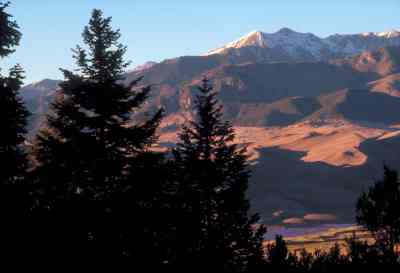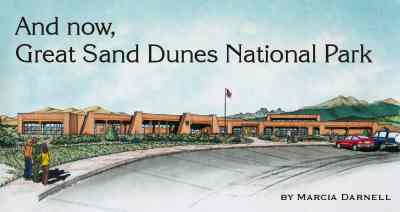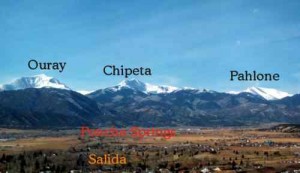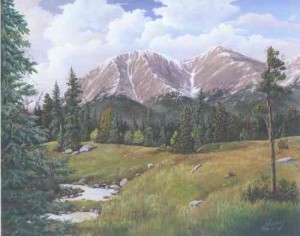Article by Marcia Darnell
Land Use – December 2004 – Colorado Central Magazine
WELL, IT’S OFFICIAL. The San Luis Valley is home to the nation’s 58th national park. The Great Sand Dunes National Monument and Preserve is no more. All hail the Great Sand Dunes National Park!

“I am pleased about it — and pleased that the hard work by so many individuals and agencies has paid off,” says Patricia Skroch, executive director of the Alamosa County Chamber of Commerce.
And in retrospect, that work has actually paid off quickly. It was December 1999, barely five years ago, when legislators, environmentalists and other community members got together at what’s been called the Dunes Summit to discuss acquiring the Baca Ranch and making a national park. The next May an act of Congress authorized the purchases. By December 2001, The Nature Conservancy, with the park service, had bought the ranch, preparatory to handing it over to the feds. The rest was legal wrangling and paperwork.
Then, on Sept. 13, 2004, Secretary of the Interior Gale Norton came to Colorado to sign documents creating the Great Sand Dunes National Park and Preserve, and at the same time she announced the creation of the new Baca National Wildlife Refuge. According to a Department of the Interior press release, “Norton said that the creation of Colorado’s fourth national park and largest wildlife refuge was inspired by the people of the San Luis Valley.”
Now that the park and wildlife refuge are a done deal, The Nature Conservancy owns and manages about half of the Baca Ranch, with the Park Service in charge of the other half. The ranch properties are closed to the public for now, but supervised visitation may be granted next year.
“I think it’s the most exciting conservation thing to happen in the West in the last decade,” says The Nature Conservancy’s project director Paul Robertson, “because of the scope of the project — it’s so large it connects other landscape-size parts, and a variety of conservancy areas throughout the Rockies.”
“It’s one of the things that makes the San Luis Valley a very special place in perpetuity,” Robertson says. “It’s a unique landscape and incredibly important to the communities, economically as well as spiritually.”
Even after the property transfers, the Nature Conservancy will still own the Medano-Zapata Ranch, which will be within the park, but Robertson anticipates that the ranch will join the park in two to three years. Until then, the conservancy will be busy developing and implementing a management plan for the land and wildlife.
“That usually takes three to five years to do,” says Robertson, “and we’re already over two years into that process.”
THE CONSERVANCY ISN’T ALONE in facing a sudden onslaught of work. Steve Chaney, head ranger of the Dunes, says the park service will be busy. “The first thing is changing the signs, which sounds trivial, but it’s very important,” he says. “CDOT just put up many ‘monument’ signs at $3,000 each.
“A new area has been added to the park that we don’t know a great deal about because access has been limited,” Chaney continues. “We need to do a lot of inventory, and decide how best to manage and protect it. There’s also a trail between the monument and preserve that hasn’t been maintained and we need to develop a strategy to protect archeological and cultural resources.”
Despite the work, Chaney and his staff are enthused about the park, and glad the wait is over. “It’s certainly a big milestone to pass, and there’s a huge amount of work ahead, as well as behind us, ” he says, “but we’re more in control of our own destiny.
The staff experienced a lot of frustration during the waiting period. “There were hundreds and thousands of little things, like printing brochures and calls from editors and publishers about when we were becoming a park,” Chaney says. “Now things are more settled. The only thing that stands in our way is time and money, not legal barriers.”
Mike Blenden, head of the Alamosa and Monte Vista Wildlife Refuges, just had 53,000 acres added to his supervisory duties, but he swears he’s happy too. “This is very exciting right now,” he says. “Last year we established the refuge with the acquisition of the White Ranch, now this will be the largest national wildlife refuge in the state.”
WITH MORE THAN 25,000 acres in the combined refuges before this acquisition, Blenden and his staff have tripled the lands they’re responsible for. “Whenever the Fish and Wildlife Service acquires a new refuge,” he says, “we write a conceptual management plan, a general direction of management of resources, how the water works, how the ground water works, how to manage the land. Not really a specific management plan, like the Dunes, but the learning curve is steep for us.
“We have lots of management and operational challenges,” Blenden continued. “That’s starting to seem very real now.”
Blenden stresses the collaboration between the agencies to manage this monster tract, and the cooperation within the Valley that made it a reality. “This is a good thing because it’s taken a target off the map for water speculators,” he says. “It’s good for our economy and environment.”
That seems to be the general sentiment in the San Luis Valley. In the aftermath of AWDI, there’s a widespread feeling of relief about having worries about water grabs off the table. In fact, many residents in the Valley feel that the protection of water is as important as conserving the land, plants and animals – or perhaps more so.
Chris Canaly was the head of Citizens for San Luis Valley Water, which was borne of the fight against AWDI. Now in charge of the SLV Ecosystem Council, she says she’s glad there was a resolution to the water war after more than a decade of struggle.

“It was a third of my life,” she says. “It’s great knowing that this huge land base will be protected.”
Canaly believes that work by the environmental organizations in the Valley helped with the transition. “That continuity helped and it established a structure so that when the national park concept came into being the Valley, the state, and the water users were already on line with the issue and we were able to transition quickly.”
Chamber director Skroch anticipates a future bounty of tourists and their dollars as a result of this action, and points to the national and international coverage of the Dunes Park. “I foresee not a huge explosion right away, but growth in tourism,” she says. “Since that’s the Valley’s second economic base, we will all benefit.”
“It began as a grassroots effort,” Skroch continues, “but our elected officials stepped up.”
Canaly echoes that sentiment. “The Valley has really hung in there together and it’s really paid off,” she says. “It’s self-actualization in terms of the communities being able to manifest their dreams.”
The park designation isn’t the only new thing at the Dunes. A new visitors center opened in October. The $2.9 million building includes a bookstore, displays on the dunes, and almost double the space of the old visitors center. There’s also more room for plant and animal specimens and for educational programs. For more information on the Great Sand Dunes National Park, call the park office, 719-378-6399.
Marcia Darnell lives in the San Luis Valley, home to many natural wonders.



